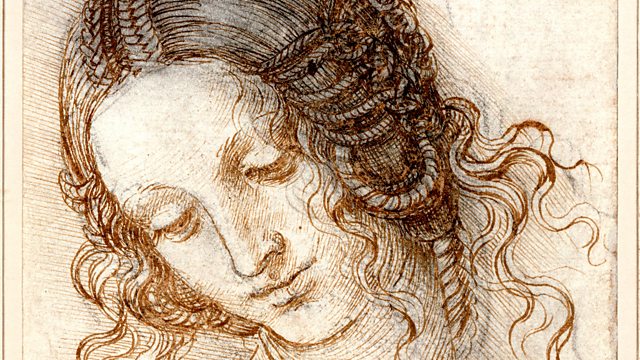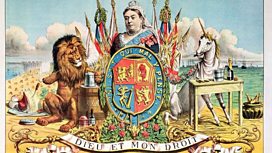Legacy
Will Gompertz examines how the monarchy has dealt with a series of dynastic crises, and explores its artistic legacy. From March 2012.
In this Diamond Jubilee year, Â鶹Éç Arts Editor Will Gompertz has been selecting some of the most revealing objects from the Royal Collection to see what they tell us about the monarchs who acquired them. It is one of the most wide-ranging collections of art and artefacts in the world, and also one of the most surprising - offering up an intriguing insight into the minds of the monarchs who assembled it.
During the course of this series, Will has encountered dozens of these unique objects - some priceless, others no more than souvenirs - each giving a glimpse into the essential characteristics of a successful sovereign. And in this, the final programme, he delves once more into the Collection to see what a subtly doctored portrait of Richard III, a bombastic mural that once hung in the Palace of Whitehall and the paintings on the Grand Staircase in Buckingham Palace tell us about how the Monarchy has dealt with a series of dynastic crises. And he joins the Royal Collection at work today and sees how Leonardo da Vinci, Johannes Vermeer and a pair of four foot candelabra are brought into the service of both Queen and country.
Producer: Paul Kobrak.
Last on
More episodes
Previous
Next
You are at the last episode
![]()
Listen to a selection of programmes and clips related to The Art of Monarchy: Legacy
Drawings by Leonardo da Vinci

The Head of Leda; Designs for Chariots and other Weapons; a Map of the Pontine Marshes, drawings by Leonardo da Vinci (1452-1519). One of the greatest treasures in the Royal Collection is the group of around 600 drawings by Leonardo da Vinci, all of which were probably acquired in a single album by Charles II.
Ìý
From: Italy. Probably acquired by Charles II (1630-1685)
Date: c.1485-1515
Material: Pen and ink and black chalk
Size: 177 x 147 mm
Ìý
Ìý
Ìý
The Whitehall Mural after Hans Holbein the Younger

Henry VII, Elizabeth of York, Henry VIII and Jane Seymour, by Remigius van Leemput (died 1675) after Hans Holbein the Younger (c. 1497-1543). This painting is a copy of a now-lost mural from the wall of the Privy Chamber at Whitehall, which had been painted by Hans Holbein the Younger (c. 1497-1543) for Henry VIII (1491-1547) in 1537.
Ìý
From: England. Commissioned by Charles II (1630-1685)
Date: 1667
Material: Oil on canvas
Size: 889 x 992 mm
Ìý
Ìý
Ìý
Ìý
Ìý
Portrait of Richard III

Richard III (1452-85), British School. The painting was recorded in Henry VIII's collection. The visual deformation of Richard III ties in with the Tudor tarnishing of the Yorkist king's reputation.
Ìý
From: England. Probably comissioned by Henry VII (1457-1509) or Henry VIII (1491-1547)
Date: c.1510-20
Material: Oil on panel
Size: 565 x 356 mm
Ìý
Ìý
Ìý
Ìý
The Hanoverian Succession

The Hanoverian Succession, by Johann Sebastian Müller (1715-1792), after Samuel Wale (1720-1786). A print celebrating the Hanoverian Succession, which commenced with the reign of George I (1660 -1727) and secured a Protestant monarchy for Great Britain.
Ìý
From: England
Date: 1752
Material: Etching and engraving
Size: 552 x 437 mm
Ìý
Ìý
Ìý
Ìý
Ìý
The Mosaic Egg, by Peter Carl Fabergé

The Mosaic Egg, by Peter Carl Fabergé (1846-1920). The egg was originally a gift from Tsar Nicolas II to Tsarina Alexandra, and contains a cameo of their 5 children. It was confiscated during the Russian Revolution shortly before the Tsar and his family were executed. It was later acquired by the Tsar's cousin, King George V of England.
Ìý
From: Russia. Acquired by King George V in 1933
Date: 1914
Material: Platinum, gold, diamond, seed pearl, topaz, rubies, demantoid garnets and enamel
Size: 95 x 70 mm
Ìý
Ìý
Ìý
The Apples of the Hesperides candelabrum

The Apples of the Hesperides candelabrum, by Paul Storr (1777-1844). The candelabrum is part of George IV's splendid service of banqueting plate, which remains in use on important State occasions to this day.
Ìý
From: England. Comissioned by George IV, when Prince Regent.
Date: 1810-17
Material: Silver-gilt
Size: 1250 x 520 x 515 mm
Ìý
Ìý
Ìý
Ìý
Ìý
More from Radio 4: The British Empire's Legacy

Melvyn Bragg and guests discuss Britain's colonial legacy. The 18th, 19th and early part of the 20th centuries were times of colonial conquest for this country but the abiding image of empire (true or not) is stuck squarely in the 1850’s when Victoria was on the throne and the world map was liberally sprinkled with red. Are there different ways of remembering that past, and what effect do these different approaches have on our present? Are we still too close to our imperial past to view it objectively, or is the reverse true - that we are too deeply rooted in our present to learn the lessons of that past?
Ìý
Broadcasts
- Sat 31 Mar 2012 10:30Â鶹Éç Radio 4
- Sat 16 Sep 2017 07:30Â鶹Éç Radio 4 Extra
- Sat 16 Sep 2017 17:30Â鶹Éç Radio 4 Extra
- Sun 17 Sep 2017 05:30Â鶹Éç Radio 4 Extra
Featured in...
![]()
Shakespeare - Portrait of the Tudor dynasty
Shakespeare - Lucas de Heere, Allegory of the Tudor Succession
Podcast
-
![]()
The Art of Monarchy
Will Gompertz examines objects in the Royal Collection that define the British monarchy.





